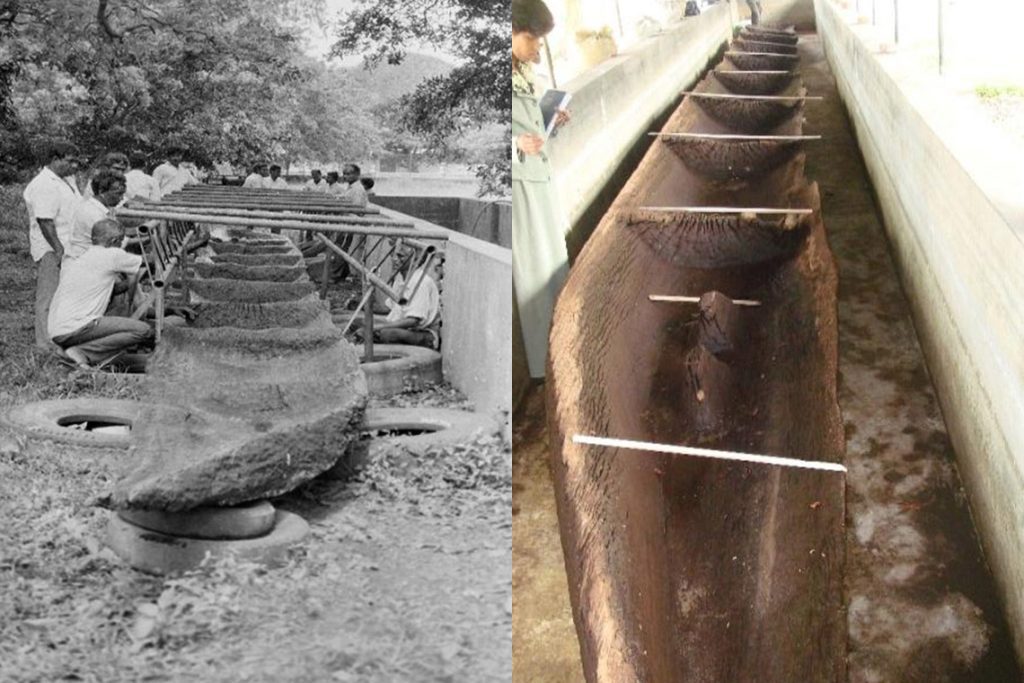The Kelani boat is the oldest of the ancient vessels found along the rivers of Sri Lanka. The Kelani boat belongs to the third century AD. It was found in the Kelani River. The vessel is now displayed in the National Museum. The Attanagalu ferry found in Attanagalu Oya belongs to the seventh century AD. That is approximately one thousand two hundred and seventy years old. An ancient boat has also been found in Ratnapura and many ancient and traditional vessels have been found in the rivers of Sri Lanka.
However, some ancient exhibits have been destroyed as a result of the sheer negligence of the Department of Archeology. The raft found in Attanagalu Oya was one such ancient find that has been completely destroyed.
The Attanagallu ferry was found in Attanagalle Oya in 1998. It is said that parts of this ferry were found by a group of sand miners.
This boat, discovered in Attanagalla Oya, was brought to the Colombo National Museum by the Department of Archeology and soaked in a water tank containing wood dust . It was to be restored at a request made by former President Chandrika Bandaranaike Kumaranatunga.
The Attanagalle ferry is 59 feet, 11 inches long. The width is 4 feet. According to carbon dating tests and chronology, this ferry is 1270 years old.
The Archeology Department was entrusted with the task of preserving the barge. The chemicals, polyethylene and glycol, were also purchased at a cost of 4 million rupees for conservation activities. However,the National Audit Office points out that this ferry was not preserved using these chemicals until 2001. The chemicals so purchased were used for two other purposes. Later, the Chemical Conservation Division of the Department of Archeology took steps to preserve this ferry using another method. The audit said that the preservation of the ferry was carried out under the dry method.
The Department of Archeology was told to take steps to display the ferry after the conservation work. But after a considerable period, no steps were taken to put it on display. The decay of the ferry had already started somewhere in 2019.
The Attannagalle ferry was built using wooden rods from the “hora” tree, and by the end of 2019, a large number of parts of the ferry had been severely decayed and turned into piles of cotton. The Department of Archeology has told the audit that natural decay may have been the reason for this.
The Ministry of Cultural Affairs arranged to appoint a committee of four professors in the year 2019 to advise the conservation department on the measures to be taken for this.The conservation of this ferry started in 2019. Plans were made to start conservation work using nylon gossamer. The price of the raw materials required for that has also increased by the day. Due to the high cost of the chemicals used for glueing these, they could not bear the cost of glueing the pieces of nylon gossamer on the boat, so the conservation work had to be stopped.
However, the committee decided that this ancient raft should be rebuilt. The Chemical Conservation Division of the Archeology Department states that they have started the reconstruction of this boat in the form of a replica using the parts that have not decayed.
As pointed out, the conservationists had no experience in using the chemicals that had been brought for the conservation of this ferry. These chemicals were used for conifers in other countries of the world. The ferry was made of fake wood, and because of this, there was no international data on how these chemicals are used for fake wood. However, the audit has stated that due to the conservation method and the work not being done properly within the specified time frame, the wooden parts of the ferry would be completely destroyed by the end of 2021.
The ferry is completely destroyed.
The extent of the damage to the ferry was such that it was reduced to small pieces of wood. In contrast, the Department of Archeology had spent 1,770,876 rupees preparing a support for the ferry’s damaged wooden parts.
But since the decayed wooden parts of the boat were beyond repair, it was brought back to the Department of Archeology to make a replica of it. From that point of view, even though an iron support was built at a cost of more than seventeen lakh rupees to place the wooden parts of this ferry, it was considered a waste of funds.
The primary role of the Department of Archeology is to explore, excavate, and preserve artefacts from archaeological sites. But the recommendation given by the audit is that these artefacts have been damaged and destroyed due to the lack of proper conservation work.
The audit shows that in the laboratory of the Department of Archeology there are a large number of antiquities found by the excavation and conservation departments since the year 1950. Some antiquities were not conserved.
Not only that, there was no formal record of antiquities found throughout the years 2020 and 2021.
The audit has also revealed that although the cataloguing has been started, a large number of antiquities are currently being preserved without any documentation.
However, the archaeological authorities have not been able to save the Attanagalla ferry, which is of historical importance. A lot of money must have been spent to retrieve the ferry from the Attanagalle Oya and bring it here. Also, there were different opinions about whether this was a boat or the wooden sticks used to build the pavilion for Upasampada Vinayakarma (a Buddhist ritual).
The former director of the National Museums Department, Dr. Sirinimal Lakdusinghe, tells a similar story about this ferry.
“This ferry was brought to the National Museum during my time. There are different opinions about this. This ferry is located beneath the Attanagalla temple for Buddhist monks’ higher ordination traditions.
The Atthanagalla Rajamaha viharaya had become an epicentre for Buddhist activities, including the practise of Upasampada Vinayakarma (higher ordination), by the end of the Anuradhapura period in the 8th century AD. Dr. Sirinimal Thiaddusinghe said.
Regardless of ideologies, the nation has lost its 1270-year-old national heritage. Where is the fault? Will there be a proper evaluation in this regard and justice meted out to these assassins of heritage?
The audit office also says that robbers of antiquities are in the Department of Archeology and the Department of Museums. All we have to ask is whether they would not be brought before the law of the country.

